Promoting the Opportunity Identification of Industrial Symbiosis: Agent-Based Modeling Inspired by Innovation Diffusion Theory
Abstract
:1. Introduction
2. Relevant Theories and Research Methods
2.1. Theoretical Perspective of Diffusion of Innovation (DoI) Theory
2.1.1. DoI Theory
2.1.2. The Development of IS as an Innovation Diffusion Process
2.1.3. Typical Models for IS Development
2.2. Stimulating IS Emergence: Strategies for Institutional Capacity Building
- Relational capacity: The ability provided by networking activities to reduce transaction costs among firms through increased trust and mutual understanding.
- Knowledge capacity: The ability to acquire and share information/knowledge that enables firms and other actors to reduce the environmental impact of their activities.
- Mobilization capacity: The ability of actors to activate and involve the firms that are necessary for IS development.
2.3. Agent-Based Modeling and Simulation (ABMS)
3. Agent-Based Model Design
3.1. The Assumptions of a Generic Industrial System
- Self-organizing (S-O) adopts a spontaneous strategy in the knowledge/attitude diffusion process of IS. The firms interact directly with each other through the self-organized inter-firm network, and spread their knowledge and opinions to their peers spontaneously without the intervention of the promoting agency.
- Knowledge coordination (K-C) is a promoting strategy where the promoting agency acts as a “knowledge banker” [40], providing firms with the ideas and knowledge of IS solutions via its connections with them. It is assumed that the promoting agency also has full knowledge about the IS solution in this scenario, and becomes one of the sources of the knowledge for the IS synergies.
- Relationship coordination (R-C) is a promoting strategy where the promoting agency acts as the relationship broker, helping the firms to build new connections and strengthen communication with each other. In this scenario, the promoting agency is not involved in the knowledge transfer.
- Combined coordination (C-C) is a promoting strategy where the promoting agency adopts both K-C and C-C to accelerate the adoption-decision making of firms.
- Except for the strategies discussed above, this model does not consider other external factors (e.g., regulations) that might lead to changes in firms’ attitudes towards the IS synergies.
- This model does not consider the participation of other R&D institutes (universities, consultants etc.).
- This model does not consider the process of knowledge generation by the firms themselves. We assume that at the beginning of the simulation, there already have been several firms (or promoting agency) that have full knowledge about certain IS synergies.
- This model neither considers the removal of established firms and inter-agent connections, nor does it consider the entry of new firms during the simulation.
- For each simulation experiment, there is only one strategy that has been employed (S-O, K-C, R-C, or C-C) in the system at the same time. That is to say, this model does not consider the shifting of strategies during the simulation.
3.2. Agents and Their Properties
3.2.1. Firm Agents
3.2.2. Promoter Agents
3.3. Agents’ Behavior and Interactions
- Exchange of knowledge with other firm agents and promoter agents.
- Decision-making about their attitude towards a specific IS solution.
- Generation of new contacts with the coordination of the promoter agent.
3.3.1. The Channel of Interactions: Network Model Construction
3.3.2. Knowledge Exchange among Agents
3.3.3. Decision-Making about the Formation of Attitude
4. Model Implementation
4.1. Simulation Process Scheduling
4.2. Implementation
5. Analysis of Results
5.1. The Performance of Promoting Strategies
5.1.1. Diffusion of Knowledge
5.1.2. Diffusion of Positive Attitudes
5.2. Sensitivity Analysis: The Influence of Rate of Promotion (ppro)
5.3. Discussion of Results
6. Conclusions and Future Research
- (1)
- The current model focuses on the identification of IS opportunity sets, and does not analyze the matching-making and decision-making processes that lead to IS implementation.
- (2)
- The current model does not take external environmental conditions into consideration; for example, policy pressure, regulation and environmental subsidies.
- (3)
- The cestimated industrial system basically consists of three types of firms and two feasible IS synergies. The diversity presented in the model is very low compared with that of industrial systems in the real world.
- (4)
- The current model is based on a relatively static community structure, where neither the entry/exit of firms nor the break of inter-agent relationships is considered.
Acknowledgments
Author Contributions
Conflicts of Interest
Abbreviations
| ABM | Agent-Based Models/Modeling |
| ABMS | Agent-Based Modeling and Simulation |
| DoI | Diffusion of Innovations |
| EIP | Eco-industrial Park |
| GSCM | Green Supply Chain Management |
| ICT | Information and Communication Technologies |
| IS | Industrial Symbiosis |
| OECD | Organization for Economic Cooperation and Development |
| TEDA | Tianjin Economic-technological Development Area |
| UML | Unified Modeling Language |
References
- Ehrenfeld, J.; Gertler, N. Industrial Ecology in Practice: The Evolution of Interdependence at Kalundborg. J. Ind. Ecol. 1997, 1, 67–79. [Google Scholar] [CrossRef]
- Chertow, M.R. INDUSTRIAL SYMBIOSIS: Literature and Taxonomy. Annu. Rev. Energy Environ. 2000, 25, 313–337. [Google Scholar] [CrossRef]
- Chertow, M.R.; Ashton, W.; Espinosa, J. Industrial Symbiosis in Puerto Rico: Environmentally Related Agglomeration Economies. Reg. Stud. 2008, 42, 1299–1312. [Google Scholar] [CrossRef]
- Massard, G.; Jacquat, O.; Wagner, L.; Zürcher, D. International Survey on Eco-Innovation Parks: Learnings from Experiences on the Spatial Dimension of Eco-Innovation; Federal Office for the Environment FOEN, ERA-NET ECO-INNOVERA: Geneva, Switzerland, 2014. [Google Scholar]
- Boons, F.; Spekkink, W.; Mouzakitis, Y. The dynamics of industrial symbiosis: A proposal for a conceptual framework based upon a comprehensive literature review. J. Clean. Prod. 2011, 19, 905–911. [Google Scholar] [CrossRef]
- Heeres, R.; Vermeulen, W.J.V.; de Dewalle, F. Eco-industrial park initiatives in the USA and the Netherlands: first lessons. J. Clean. Prod. 2004, 12, 985–995. [Google Scholar] [CrossRef]
- Gibbs, D. Trust and networking in inter-firm relations: The case of eco-industrial development. Local Econ. 2003, 18, 222–236. [Google Scholar] [CrossRef]
- Boons, F.; Baas, L.W. Types of industrial ecology: The problem of coordination. J. Clean. Prod. 1997, 5, 79–86. [Google Scholar] [CrossRef]
- Baas, L.W.; Boons, F. An industrial ecology project in practice: Exploring the boundaries of decision-making levels in regional industrial systems. J. Clean. Prod. 2004, 12, 1073–1085. [Google Scholar] [CrossRef]
- Lambert, A.; Boons, F. Eco-industrial parks: Stimulating sustainable development in mixed industrial parks. Technovation 2002, 22, 471–484. [Google Scholar] [CrossRef]
- Korhonen, J.; Snäkin, J.-P. Analysing the evolution of industrial ecosystems: Concepts and application. Ecol. Econ. 2005, 52, 169–186. [Google Scholar] [CrossRef]
- Ashton, W. Understanding the Organization of Industrial Ecosystems: A social network approach. J. Ind. Ecol. 2008, 12, 34–51. [Google Scholar] [CrossRef]
- Gibbs, D.; Deutz, P. Reflections on implementing industrial ecology through eco-industrial park development. J. Clean. Prod. 2007, 15, 1683–1695. [Google Scholar] [CrossRef]
- Mirata, M.; Emtairah, T. Industrial symbiosis networks and the contribution to environmental innovation: The case of the Landskrona industrial symbiosis programme. J. Clean. Prod. 2005, 13, 993–1002. [Google Scholar] [CrossRef]
- Paquin, R.L.; Howard-Grenville, J.A. Facilitating Regional Industrial Symbiosis: Network Growth in the UK’s National Industrial Symbiosis Programme. In The Social Embeddedness of Industrial Ecology; Boons, F., Howard-Grenville, J.A., Eds.; Edward Elgar Publishing: Northampton, UK, 2009; pp. 103–128. [Google Scholar]
- Boons, F.; Howard-Grenville, J.A. Introducing the social embeddedness of industrial ecology. In The Social Embeddedness of Industrial Ecology; Boons, F., Howard-Grenville, J.A., Eds.; Edward Edgar: Cheltenham, UK, 2009; pp. 3–27. [Google Scholar]
- Boons, F.; Spekkink, W. Levels of Institutional Capacity and Actor Expectations about Industrial Symbiosis. J. Ind. Ecol. 2012, 16, 61–69. [Google Scholar] [CrossRef]
- Boons, F. Connecting levels: A systems view on stakeholder dialogue for sustainability. Prog. Ind. Ecol. Int. J. 2004, 1, 385–396. [Google Scholar] [CrossRef]
- Andrews, C.J. Building a Micro Foundation for Industrial Ecology. J. Ind. Ecol. 2001, 4, 35–51. [Google Scholar] [CrossRef]
- Yu, C.; De Jong, M.; Dijkema, G.P.J. Process analysis of eco-industrial park development—The case of Tianjin, China. J. Clean. Prod. 2014, 64, 464–477. [Google Scholar] [CrossRef]
- Romero, E.; Ruiz, M.C. Proposal of an agent-based analytical model to convert industrial areas in industrial eco-systems. Sci. Total Environ. 2014, 468–469, 394–405. [Google Scholar] [CrossRef] [PubMed]
- Rogers, E.M. Diffusion of Innovations, 5th ed.; The Free Press, A Division of Simon & Schuster, Inc.: New York, NY, USA, 2003. [Google Scholar]
- Rennings, K. Redefining innovation—Eco-innovation research and the contribution from ecological economics. Ecol. Econ. 2000, 32, 319–332. [Google Scholar] [CrossRef]
- Aquilani, B.; Silvestri, C.; Ioppolo, G.; Ruggieri, A. The challenging transition to bio-economies: Towards a new framework integrating corporate sustainability and value co-creation. J. Clean. Prod. 2017. forthcoming. [Google Scholar] [CrossRef]
- OECD. OECD Project on Green Growth & Eco-innovation: Nominate Examples of “Radical and Systemic” Eco-Innovation. Available online: http://www.oecd.org/science/inno/45169190.pdf (accessed on 20 March 2016).
- Zhu, Q.; Sarkis, J.; Lai, K.-H. Green supply chain management innovation diffusion and its relationship to organizational improvement: An ecological modernization perspective. J. Eng. Technol. Manag. 2012, 29, 168–185. [Google Scholar] [CrossRef]
- Zhu, Q.; Tian, Y.; Sarkis, J. Diffusion of selected green supply chain management practices: An assessment of Chinese enterprises. Prod. Plan. Control 2012, 23, 837–850. [Google Scholar] [CrossRef]
- Paquin, R.L.; Howard-Grenville, J.A. The Evolution of Facilitated Industrial Symbiosis. J. Ind. Ecol. 2012, 16, 83–93. [Google Scholar] [CrossRef]
- Ghali, M.R.; Frayret, J.-M.; Robert, J.-M. Green social networking: Concept and Potential Applications to Initiate Industrial Synergies. J. Clean. Prod. 2015, 115, 23–35. [Google Scholar] [CrossRef]
- Chertow, M.R. “Uncovering” Industrial Symbiosis. J. Ind. Ecol. 2007, 11, 11–30. [Google Scholar] [CrossRef]
- Costa, I.; Ferrão, P.C. A case study of industrial symbiosis development using a middle-out approach. J. Clean. Prod. 2010, 18, 984–992. [Google Scholar] [CrossRef]
- Wang, Q. Knowledge Transfer to Facilitate Industrial Symbiosis: A Case Study of UK-China Collaborators. Ph.D. Thesis, University of Hull, Hull, UK, 2013. [Google Scholar]
- Aid, G.; Brandt, N.; Lysenkova, M.; Smedberg, N. Looplocal—A heuristic visualization tool to support the strategic facilitation of industrial symbiosis. J. Clean. Prod. 2015, 98, 328–335. [Google Scholar] [CrossRef]
- Hatefipour, S. Facilitation of Industrial Symbiosis Development in a Swedish Region. Ph.D. Thesis, Linköping University, Linköping, Sweden, 2012. [Google Scholar]
- Boons, F.; Spekkink, W.; Jiao, W. A Process Perspective on Industrial Symbiosis. J. Ind. Ecol. 2014, 18, 341–355. [Google Scholar] [CrossRef]
- Dijkema, G.; Basson, L. Complexity and industrial ecology: Foundations for a Transformation from Analysis to Action. J. Ind. Ecol. 2009, 13, 157–164. [Google Scholar] [CrossRef]
- Kiesling, E.; Günther, M.; Stummer, C.; Wakolbinger, L.M. Agent-based simulation of innovation diffusion: A review. Cent. Eur. J. Oper. Res. 2012, 20, 183–230. [Google Scholar] [CrossRef]
- Axtell, R.L.; Andrews, C.J.; Small, M.J. Agent-Based Modeling and Industrial Ecology. J. Ind. Ecol. 2001, 5, 10–13. [Google Scholar] [CrossRef]
- Janssen, M.A. Agent-Based Analysis of Dynamic Industrial Ecosystems: An Introduction. In Changing Stocks, Flows and Behaviors in Industrial Ecosystems; Ruth, M., Davidsdottir, B., Eds.; Edward Elgar Publishing: Cheltenham, UK, 2008; pp. 157–162. [Google Scholar]
- Von Malmborg, F. Networking for knowledge transfer: Towards an understanding of local authority roles in regional industrial ecosystem management. Bus. Strateg. Environ. 2004, 13, 334–346. [Google Scholar] [CrossRef]
- Taddeo, R.; Simboli, A.; Ioppolo, G.; Morgante, A. Industrial Symbiosis, Networking and Innovation: The Potential Role of Innovation Poles. Sustainability 2017, 9, 169. [Google Scholar] [CrossRef]
- Ioppolo, G.; Cucurachi, S.; Salomone, R.; Saija, G.; Shi, L. Sustainable Local Development and Environmental Governance: A Strategic Planning Experience. Sustainability 2016, 8, 180. [Google Scholar] [CrossRef]
- Watts, D.J.; Strogatz, S.H. Collective dynamics of “small-world” networks. Nature 1998, 393, 440–442. [Google Scholar] [CrossRef] [PubMed]
- Baum, J.A.C.; Shipilov, A.V.; Rowley, T.J. Where do small worlds come from? Ind. Corp. Chang. 2003, 12, 697–725. [Google Scholar] [CrossRef]
- Uzzi, B.; Amaral, L.A.; Reed-Tsochas, F. Small-world networks and management science research: A review. Eur. Manag. Rev. 2007, 4, 77–91. [Google Scholar] [CrossRef]
- Watts, D.J. The “New” Science of Networks. Annu. Rev. Sociol. 2004, 30, 243–270. [Google Scholar] [CrossRef]
- Cowan, R. Network models of innovation and knowledge diffusion. In Clusters, Networks, and Innovation; Bresch, S., Malerba, F., Eds.; Oxford University Press: Oxford, UK, 2005; pp. 29–53. [Google Scholar]
- Cowan, R.; Jonard, N.; Özman, M. Knowledge dynamics in a network industry. Technol. Forecast. Soc. Chang. 2004, 71, 469–484. [Google Scholar] [CrossRef]
- Valente, T.W. Social network thresholds in the diffusion of innovations. Soc. Netw. 1996, 18, 69–89. [Google Scholar] [CrossRef]
- Wilensky, U. Netlogo 1999. Available online: http://ccl.northwestern.edu/netlogo/ (accessed on 11 May 2016).
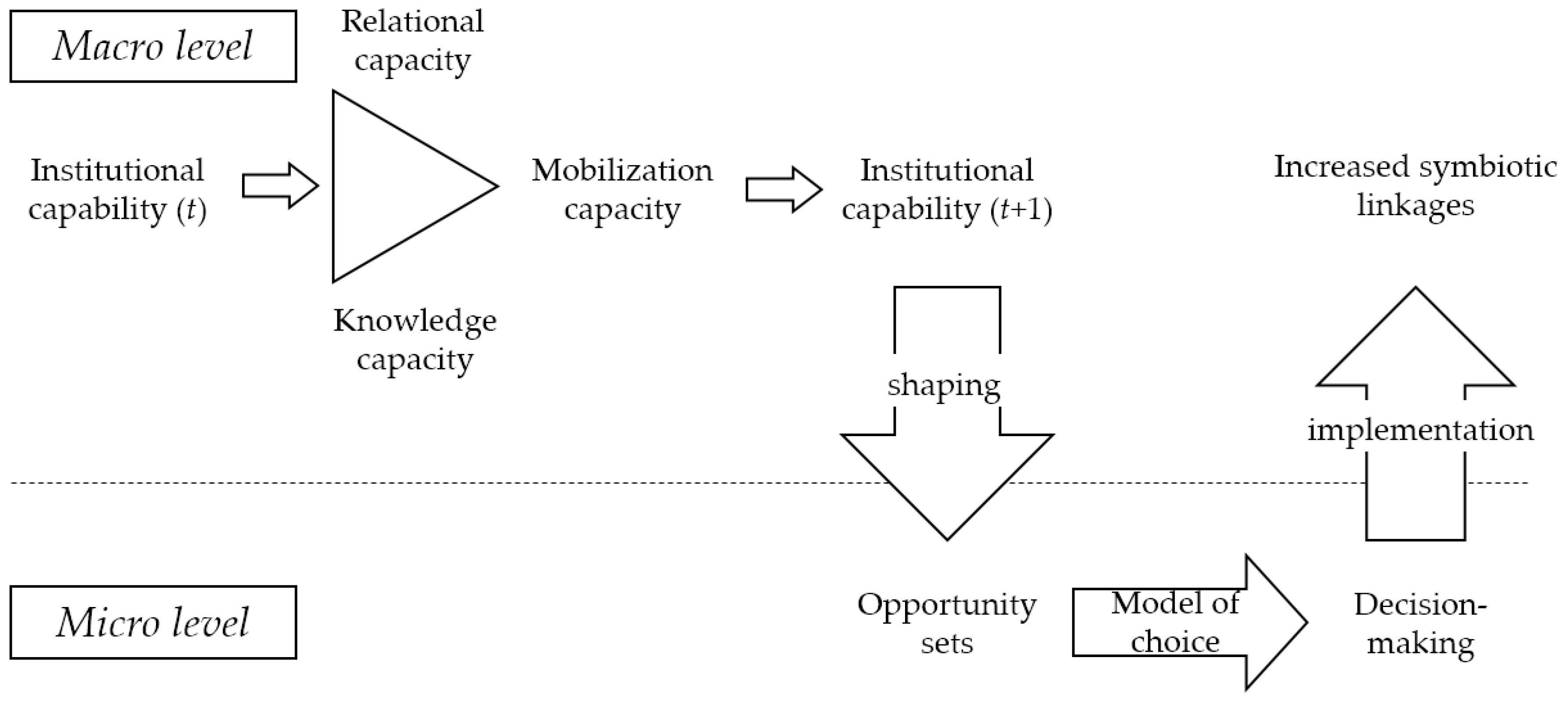
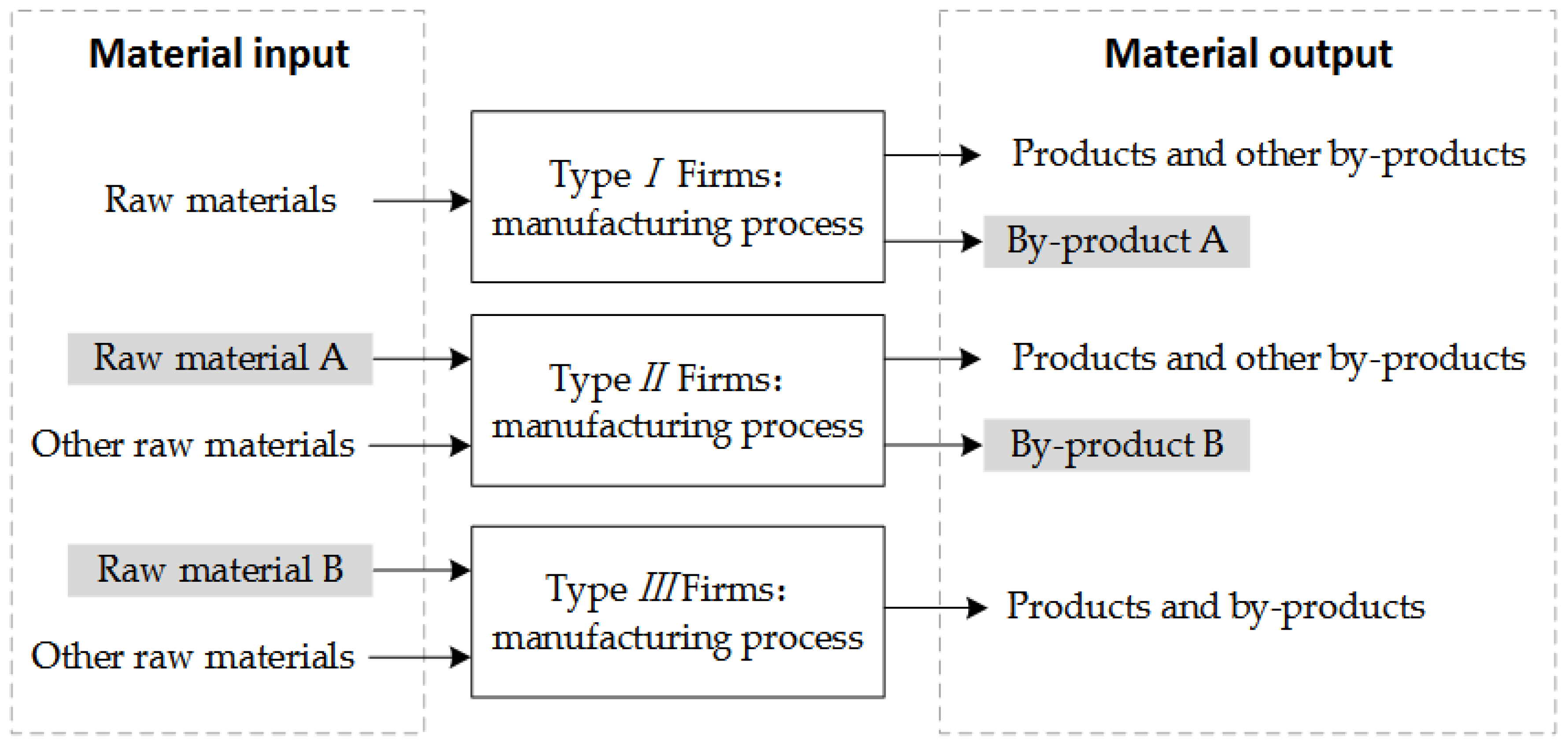
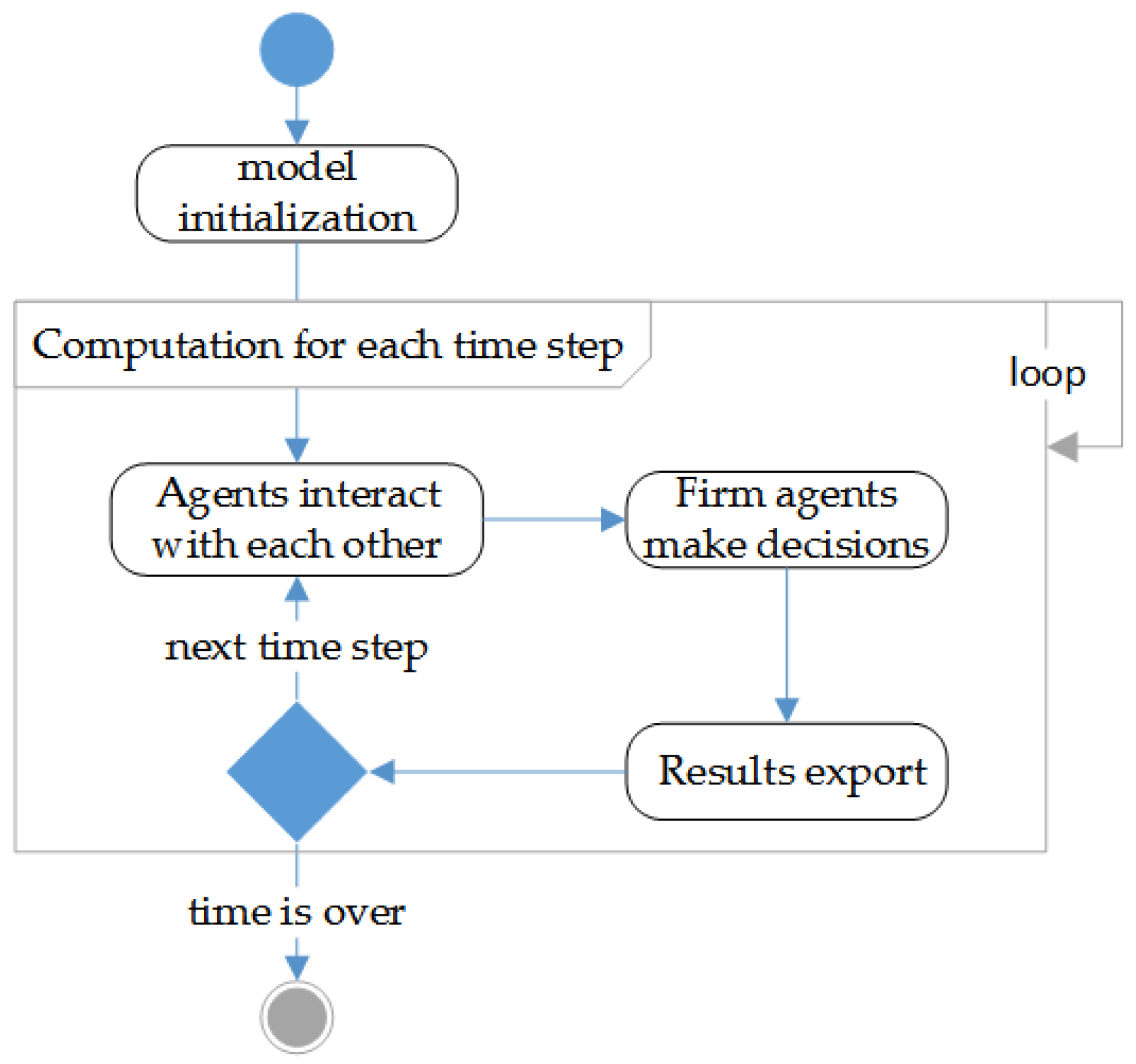

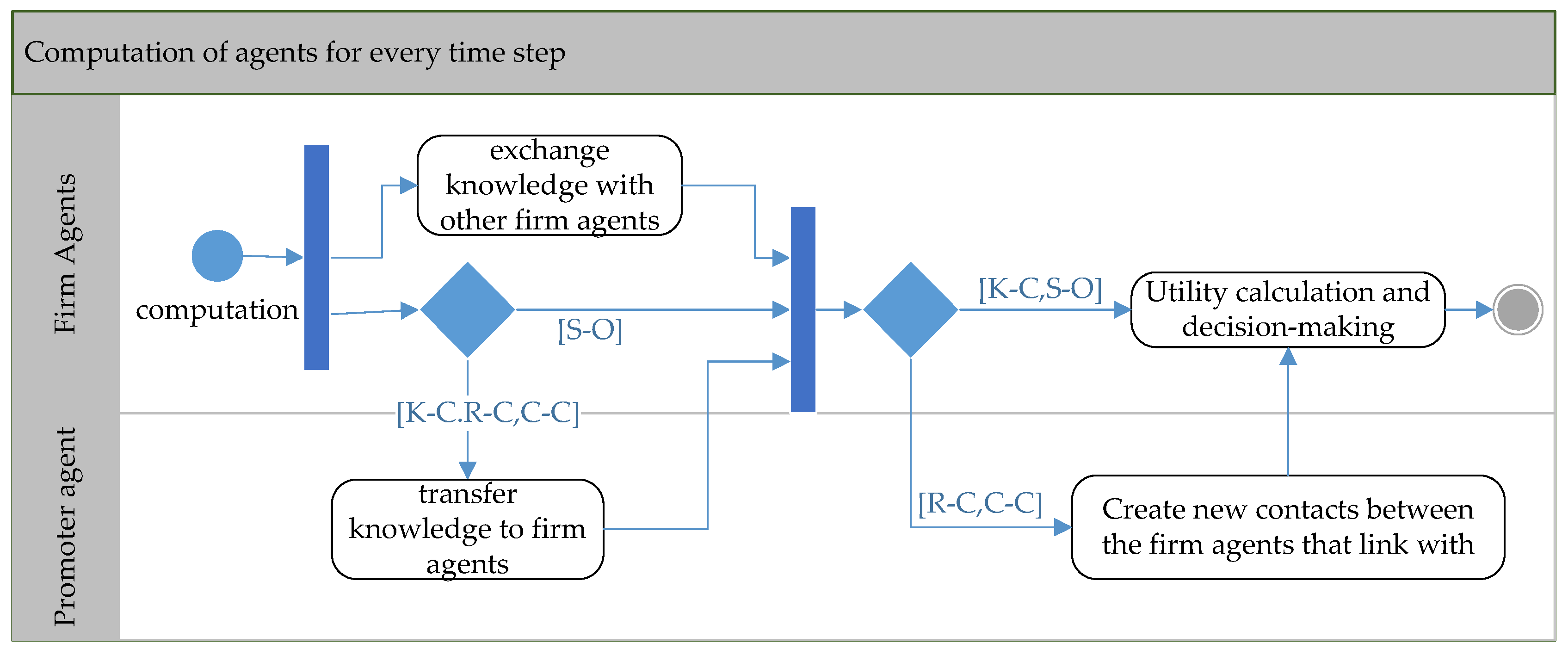
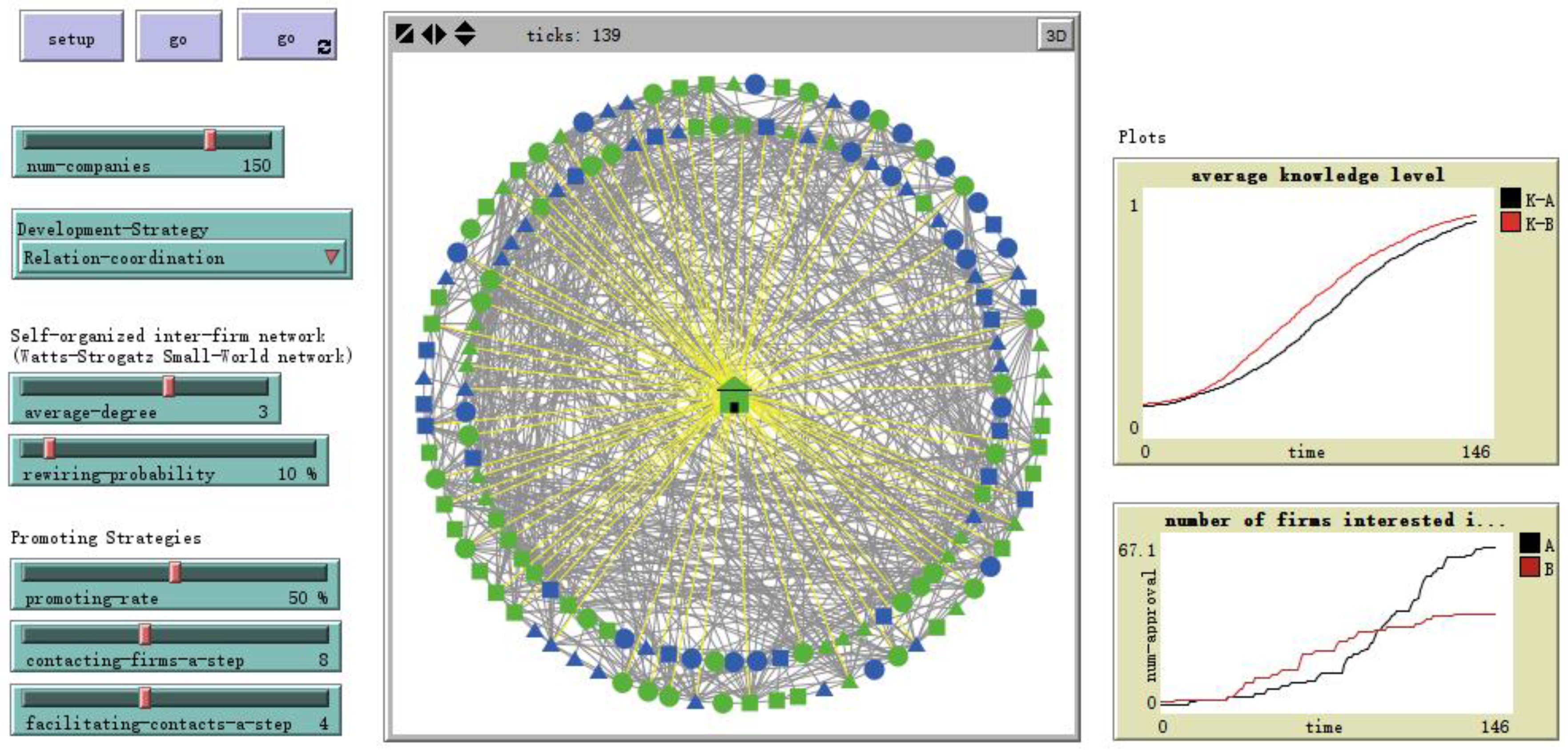
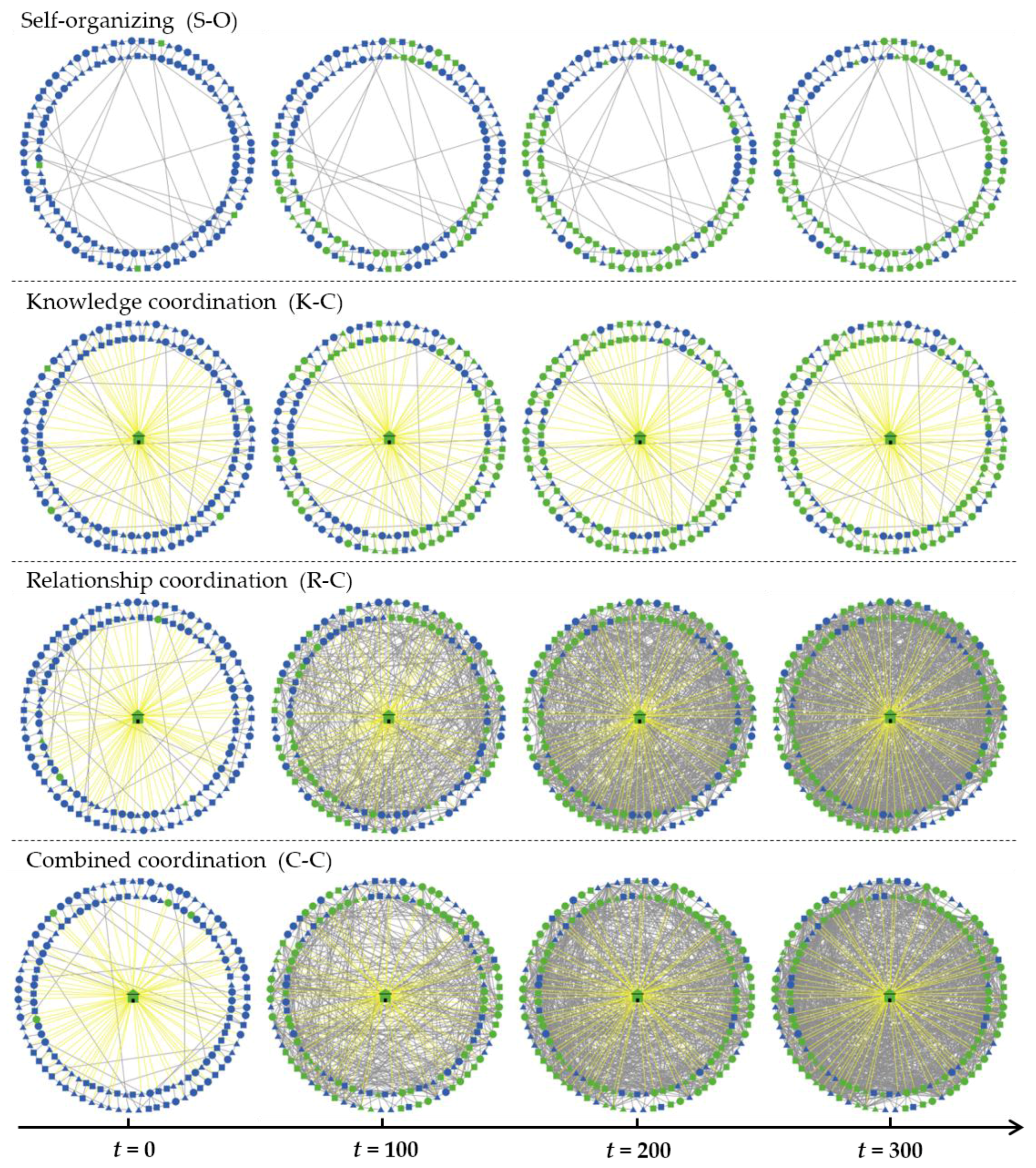
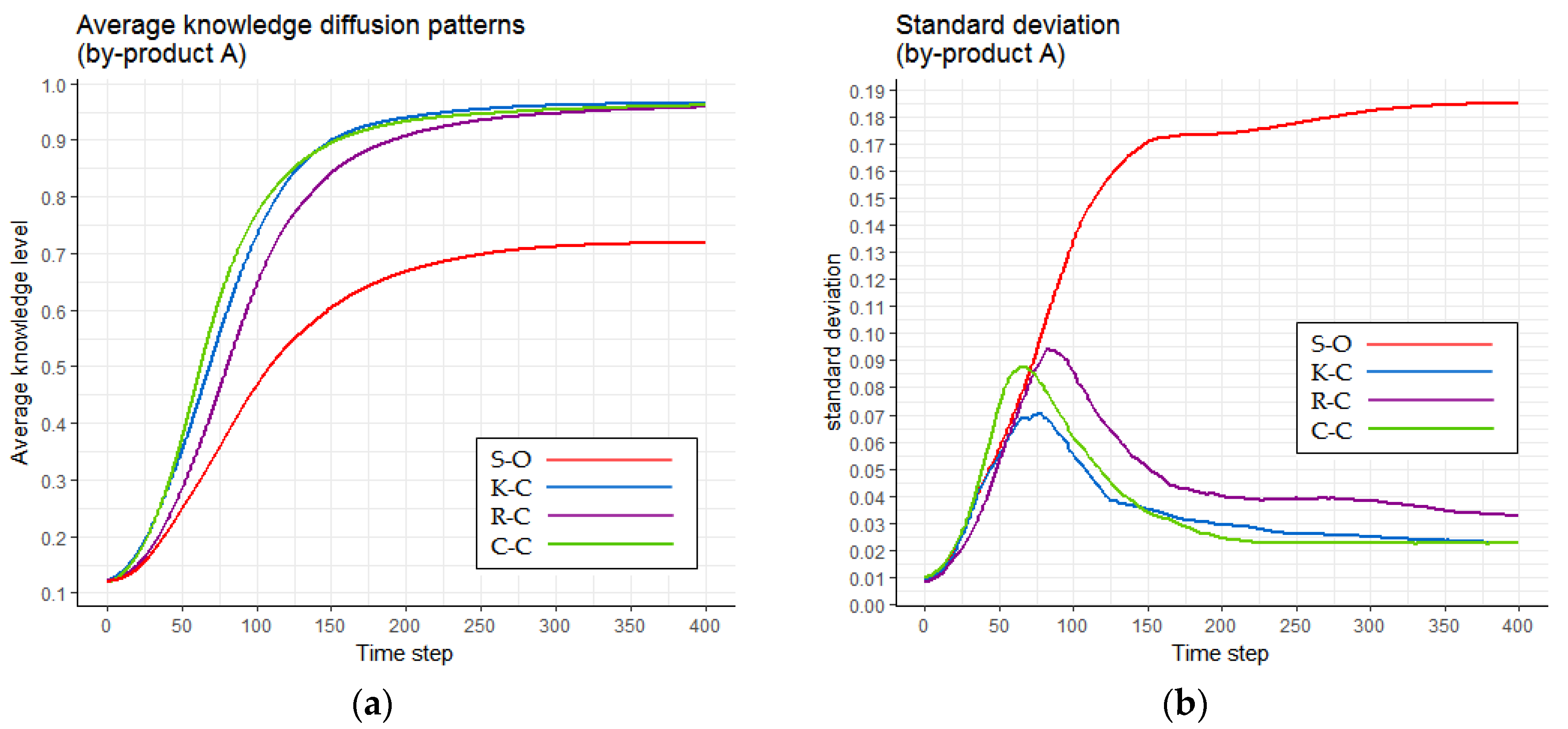
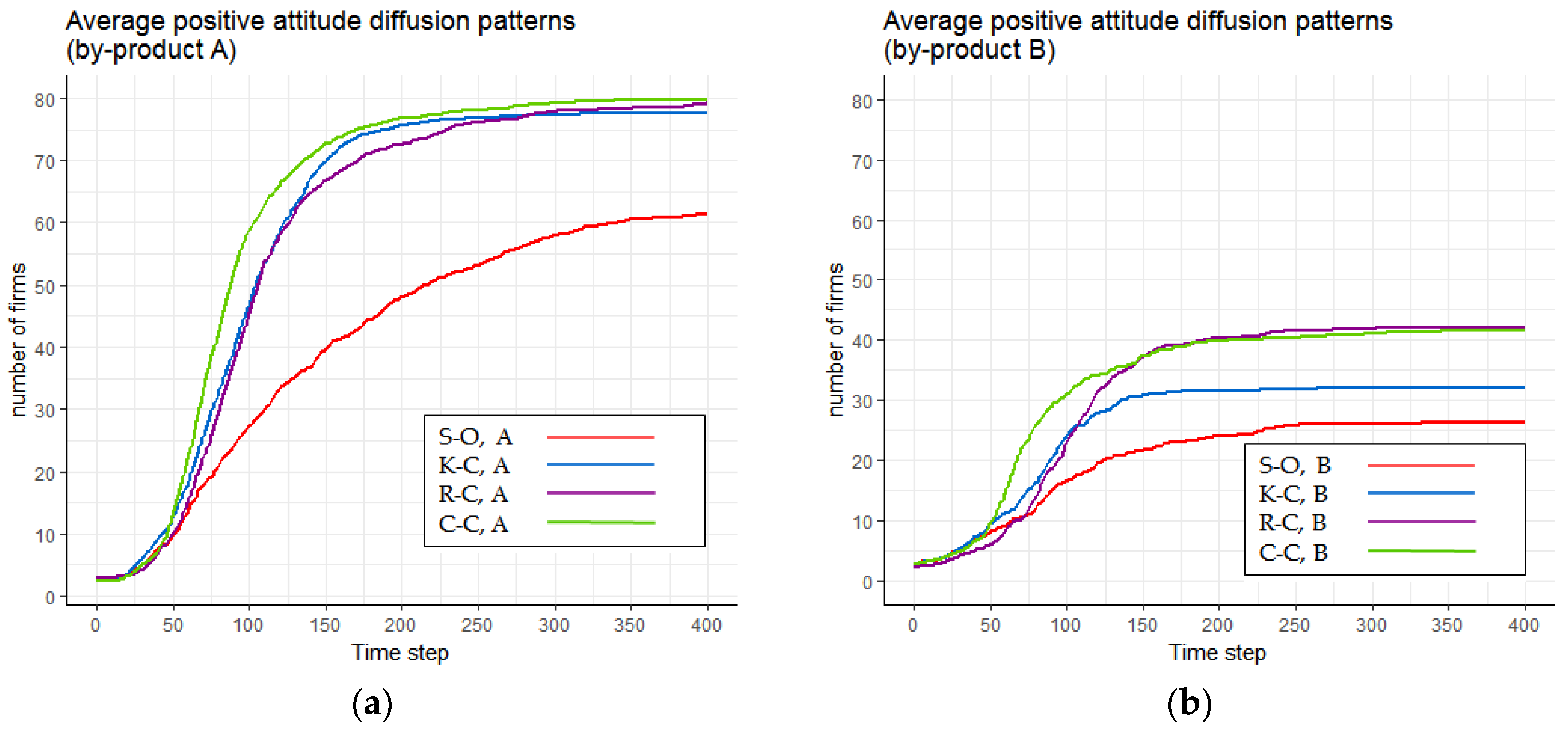
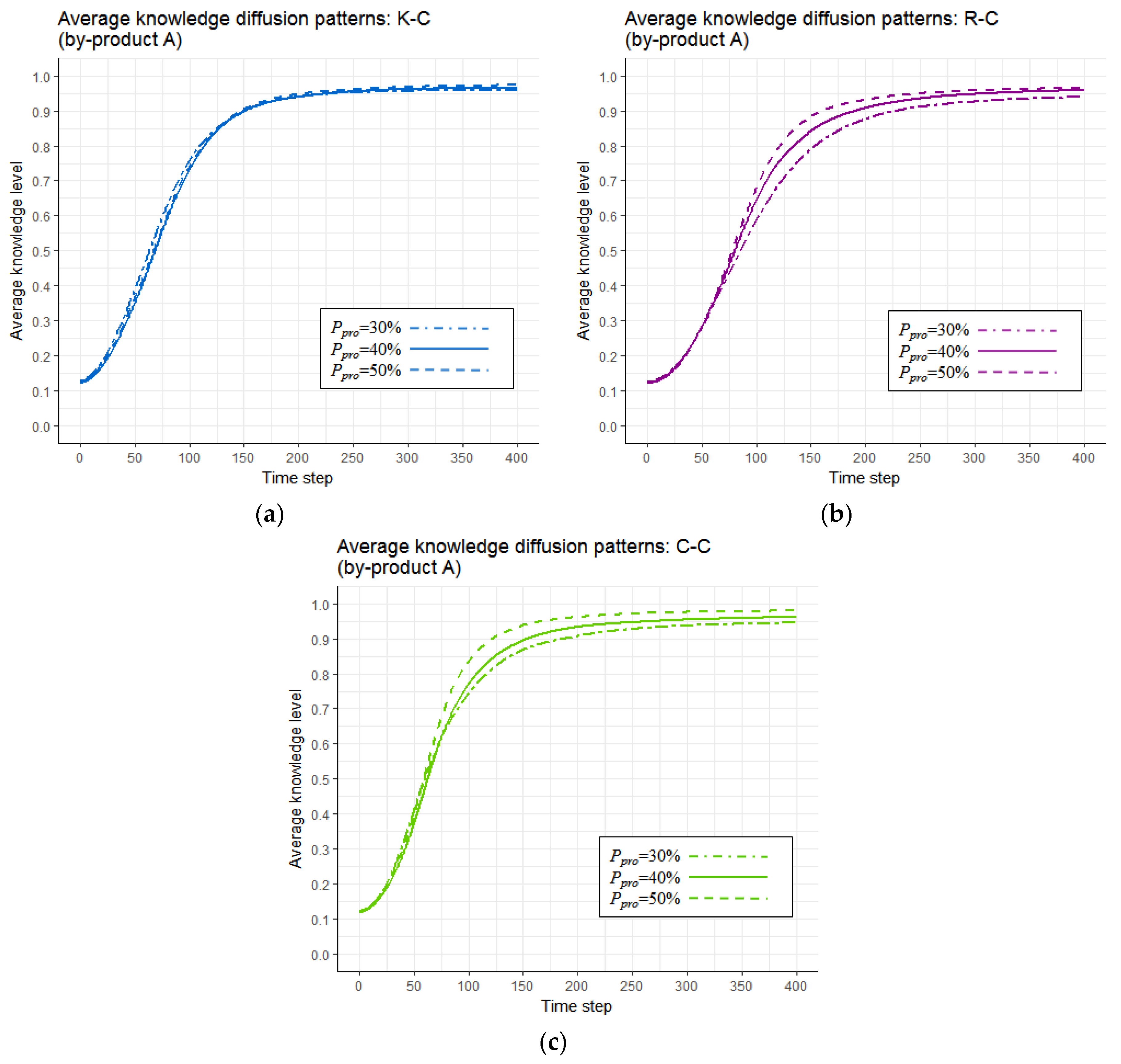
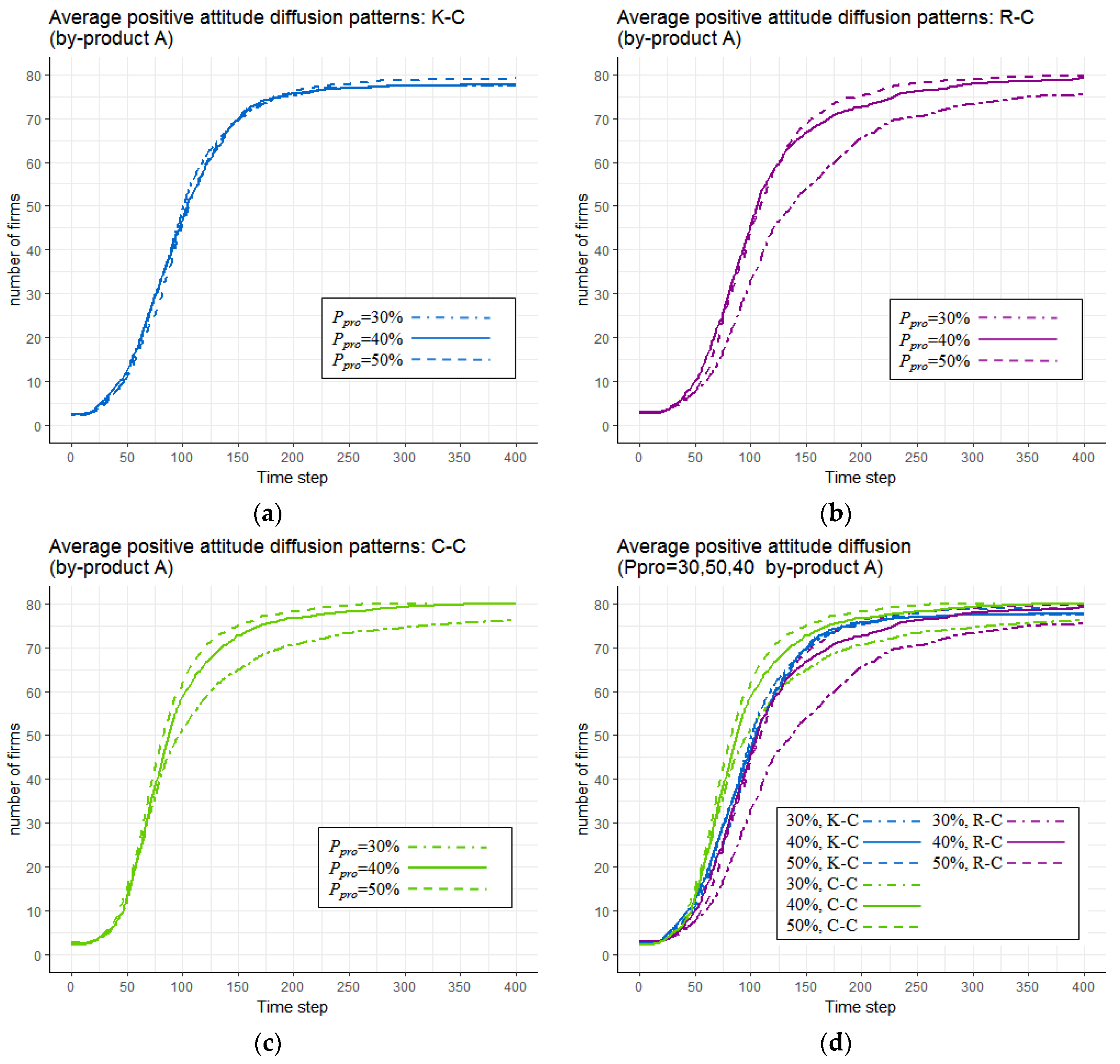

| Self-Organizing | Planned | Facilitated | |
|---|---|---|---|
| Corresponding Diffusion Systems | Decentralized | Centralized | Hybrid |
| Direction of diffusion | Among the firms (that could be considered as the potential adopters of IS knowledge, positive attitude and practice) through their horizontal networks. | One-way direction from the promoting agency to firms. In the context of planned IS, the promoting agency (usually a governmental agency) acts as the central planner. | Among firms through the coordination of the promoting agency, as well as from the promoting agency. In the context of facilitated IS, the promoting agency is usually a third-party organization who acts as facilitator. |
| Source of innovations | Innovations come from the firms who are also the potential adopters. | Innovations come from R&D, introduced by the promoting agency (central planner). | Innovations come from the firms themselves as well as the R&D introduced by the promoting agency (facilitator). |
| Who decide the innovation | The firms themselves. | Top administrators and technical subject-matter experts (in the context of planned IS, represented by the central planner). | The firms themselves. In addition, top administrators might be involved in the introduction of some very promising innovations (coordinated by the facilitator). |
| Degree of centralization in innovation-decision | Sharing of control among the firms themselves; or client control by the opinion leaders in the firms. | Overall controlled by the top administrators and technical subject-matter experts (represented by the central planner). | Sharing of control among the firms themselves; or client control by the opinion leaders. Alternatively, decisions on some promising innovations might follow the centralized model. |
| Category | Label | Name | Description |
|---|---|---|---|
| Inherent properties | Industrial type | For agent , . The value of indicates that the agent is one of the type I , type II or type III firms. | |
| Processed material | In the model, we only consider the material
—the two materials that can be involved in the potential by-product synergies. For firm agent , the materials it needs to process are presented by a vector , . For a firm agent, means it need to process material , otherwise it needs not. According to Figure 2, for a firm agent:
| ||
| Adopter category | Rogers (2003) defined five adopter categories—innovators, early adopters, early majority, late majority, and laggards—on the basis of innovativeness [22] (p. 297). indicates the adopter category of firm agent . The firm agents labeled as “innovator”, have full knowledge of potential IS synergies, and act as the starting points of the diffusion process. is an influential factor for other properties of firm agent , such as its capability to gain knowledge about eco-innovations (), the utility threshold for it to approve the IS solution , and its perceptual capability to sense the sounding influences about certain eco-innovations (). | ||
| Knowledge capability | For firm agent , is its capability to absorb the knowledge of a specific innovation. The value ofis determined by the agent’s . For example, the agent, which is an innovator or early adopter, obtains a higher value of . | ||
| Utility threshold | For firm agent , is the minimum utility value needed to form a positive attitude towards the idea of an eco-innovation. is a constant value determined by . For example, as an early adopter, the agent needs a relatively lower utility threshold to adopt a new idea, while the laggards need more evidence to prove the utility of the innovation. | ||
| Perceptual capability | Agent s’ perceptual ability to sense the sounding influences about certain eco-innovations, the value of is determined by the agent’s . | ||
| Status properties | Knowledge | The vector , indicates firms’ knowledge level about a specific IS solution for the process of material . The firm agent updates its knowledge after the interaction with other agents. Moreover, is also determined by in a way that if , then , which means the agent will not get involved in the knowledge exchanges if it is irrelevant to them. At the initial stage, assume that the firm agents have a basic understanding about their processed materials, that is, if , then . The knowledge algorithm will be given later in Section 3.3.2. | |
| Attitude | The vector indicates firm agent ’s attitude towards all the possible IS solutions for the process of material . Each element ) of vector represents firm agent i’s attitude towards one specific IS solution. If , firm agent has approved and accepted the idea of the corresponding IS solution. Otherwise, . The attitude algorithm will be given in Section 3.3.3. | ||
| Utility | For firm agent , is the utility it has evaluated about a specific IS solution for the process of material . The calculation of will be given in Section 3.3.3. | ||
| Perceived external influence | For firm agent , is the overall attitude of its external environment it has perceived towards IS solution about . The calculation of will be given in Section 3.3.3. |
| Label | Name | Description |
|---|---|---|
| Types of promoting strategy | determines the strategies employed by the promoter agent. As discussed above, the strategies employed by the promoter agent considered in the proposed research including “knowledge coordination”, “relationship coordination” and “combined coordination” (i.e., the combination of “knowledge coordination” and “relationship coordination”). | |
| Rate of promotion | is the percentage of the firm agents in the industrial system that the promoter agent has connected with. reflects the mobilization capacity brought by the promoter agent. | |
| Number of contacted firms at each time step | When the promoter employs the strategy of knowledge coordination (K-C), at each time step, it contacts a certain number () of firm agents it has linked to transfer knowledge to them. | |
| Promoter’s Knowledge | When the promoter employs the strategy of knowledge coordination (K-C), we assume that the promoter has the full knowledge of the available IS solutions in this system, that is, . | |
| Number of coordinated pairs at each time step | When the promoter employs the strategy of relationship coordination (R-C), the promoter agent facilitates the communication and relationship building between firm agents it has linked with. At every time step, the promoter facilitates pair of firm agents to make them communicate or build new contacts with each other. |
| Variables | Initial Values | Notes |
|---|---|---|
| The number of firm agents | 150 | |
| The proportion of firms: (type I:type II:type III) | 1:1:1 | If = 150, thus there are 50 type I firms, 50 type II firms and 50 type III firms. As such, There are 100 potential adopters (the total number of type I and type II firms) of the solution of by-product and 100 potential adopters (the total number of type II and type III firms) of the solution of by-product. |
| The proportion of firms: (innovators:early adopters:early majority:late majority:laggards) | 2.5%:13.5%:34%:34%:16% 1 | If = 150, randomly divide the firm agents into four categories, then there are approximately 4 innovators (set = 0), 20 early adopters (set = 1), 51 early majority (set = 2), 51 late majority (set = 3) and 24 laggards (set = 4). |
| Average degree of the inter-firm small-world network | 3 | |
| The rewiring probability of the inter-firm small-world network | 0.1 | |
| Initial weight of the inter-firm linkage | 1 | |
| The weight of external influence when making decision (, ) | = 0.3 = 0.5 | The value indicates greater uncertainty of implementation of the IS solution for by-product . |
| Threshold | 0.6 | |
| Basic knowledge level of firms | 0.1 | |
| Simulation time period | 400 | A simulation lasts for 400 time steps. |
| Agents | Variables | Initial Values |
|---|---|---|
| Firm agents | : Initial knowledge of the material that firm agent need to process | If , ; if , ; if , . |
| : Knowledge capability of firms | If , 1, ; if , ; if, ; if, . | |
| : Perceptual capability of firms | If , 1, ; if , ; if, ; if, . | |
| : Utility threshold for firms to approve the IS solution | If , 1, ; if , ; if, ; if, . | |
| Promoter agent | : Knowledge of promoter agent | |
| : Number of contacted firms at every time step | 8 | |
| : Number of coordinated pairs at every time step | 4 | |
| : The percentage of firm agents that the promoter agent has connected with | 40% | |
| : The promoting strategies that are employed | knowledge coordination (K-C) relationship coordination (R-C) combined coordination (C-C) |
| PT | Promoting Strategies | |||
|---|---|---|---|---|
| ppro | K-C | R-C | C-C | |
| 40% | 40%, K-C (baseline) | 40%, R-C (baseline) | 40%, C-C (baseline) | |
| 30% | 30%, K-C | 30%, R-C | 30%, C-C | |
| 50% | 50%, K-C | 50%, R-C | 50%, C-C | |
© 2017 by the authors. Licensee MDPI, Basel, Switzerland. This article is an open access article distributed under the terms and conditions of the Creative Commons Attribution (CC BY) license (http://creativecommons.org/licenses/by/4.0/).
Share and Cite
Zheng, K.; Jia, S. Promoting the Opportunity Identification of Industrial Symbiosis: Agent-Based Modeling Inspired by Innovation Diffusion Theory. Sustainability 2017, 9, 765. https://doi.org/10.3390/su9050765
Zheng K, Jia S. Promoting the Opportunity Identification of Industrial Symbiosis: Agent-Based Modeling Inspired by Innovation Diffusion Theory. Sustainability. 2017; 9(5):765. https://doi.org/10.3390/su9050765
Chicago/Turabian StyleZheng, Kaifang, and Suling Jia. 2017. "Promoting the Opportunity Identification of Industrial Symbiosis: Agent-Based Modeling Inspired by Innovation Diffusion Theory" Sustainability 9, no. 5: 765. https://doi.org/10.3390/su9050765





